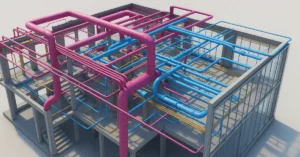BIM Integration in South Korean Construction Projects
Building Information Modeling (BIM) has revolutionized the construction industry worldwide, and South Korea is no exception. As a method that involves the generation and management of digital representations of physical and functional characteristics of places, BIM has become a pivotal tool in the construction sector. In South Korea, a country known for its rapid technological advancements and robust infrastructure, BIM integration in construction projects is gaining significant traction. This blog will delve into the intricacies of BIM integration in South Korean construction projects, exploring its benefits, challenges, implementation strategies, and future prospects.
The Emergence of BIM in South Korea
The construction industry in South Korea has always been at the forefront of adopting new technologies. With the government’s push towards smart cities and sustainable development, BIM has emerged as a critical component in achieving these goals. The Ministry of Land, Infrastructure, and Transport (MOLIT) has been instrumental in promoting BIM adoption through various policies and initiatives. In 2016, MOLIT announced a roadmap for BIM adoption, mandating its use in public projects over a certain size by 2020. This move has significantly accelerated the integration of BIM in the construction sector.
Benefits of BIM in South Korean Construction Projects
- Enhanced Collaboration and Communication: BIM provides a shared digital environment that enhances collaboration among all stakeholders, including architects, engineers, contractors, and clients. This collaborative approach reduces misunderstandings and errors, leading to more efficient project execution.
- Improved Project Visualization: BIM enables the creation of detailed 3D models that provide a comprehensive view of the project. This visualization helps stakeholders understand the design and identify potential issues early in the project lifecycle.
- Increased Efficiency and Productivity: BIM automates many aspects of the construction process, such as quantity take-offs and cost estimation. This automation reduces manual work, minimizes errors, and increases overall productivity.
- Enhanced Quality and Safety: BIM facilitates clash detection, which identifies and resolves conflicts between different building systems before construction begins. This proactive approach enhances the quality and safety of the construction process.
- Sustainability and Energy Efficiency: BIM supports the design and construction of energy-efficient buildings by providing tools for energy analysis and simulation. This capability is crucial in South Korea’s efforts to promote sustainable development.
Challenges in BIM Integration
Despite the numerous benefits, BIM integration in South Korean construction projects faces several challenges:
- High Initial Costs: Implementing BIM requires a significant investment in software, hardware, and training. Many small and medium-sized construction firms find it challenging to bear these initial costs.
- Lack of Skilled Professionals: There is a shortage of professionals with expertise in BIM in South Korea. This skills gap hinders the widespread adoption of BIM across the industry.
- Resistance to Change: Many stakeholders in the construction industry are resistant to adopting new technologies. This resistance stems from a lack of awareness about the benefits of BIM and a preference for traditional methods.
- Interoperability Issues: Different BIM software tools may not be fully compatible with each other, leading to interoperability issues. This lack of standardization can hinder seamless collaboration and data exchange.
- Legal and Contractual Issues: The legal and contractual frameworks in South Korea have not fully adapted to the requirements of BIM. This gap creates uncertainties regarding data ownership, intellectual property rights, and liability.
Strategies for Successful BIM Integration
To overcome these challenges and ensure successful BIM integration in South Korean construction projects, several strategies can be adopted:
- Government Support and Regulation: The South Korean government should continue to play a proactive role in promoting BIM adoption through policies, incentives, and regulations. Mandating BIM use in public projects and providing financial support to small and medium-sized enterprises (SMEs) can accelerate BIM integration.
- Education and Training: There is a need for comprehensive education and training programs to develop BIM skills among construction professionals. Universities, technical institutes, and industry associations should collaborate to offer specialized courses and certifications in BIM.
- Standardization and Interoperability: Establishing national BIM standards and promoting the use of open data formats can address interoperability issues. Standardization will facilitate seamless collaboration and data exchange among different stakeholders.
- Awareness and Advocacy: Raising awareness about the benefits of BIM through seminars, workshops, and industry conferences can help overcome resistance to change. Industry leaders and early adopters should share their success stories to demonstrate the value of BIM.
- Collaboration and Partnerships: Encouraging collaboration between the government, academia, and the private sector can drive innovation and knowledge sharing in BIM. Public-private partnerships can also facilitate the development of BIM infrastructure and resources.
Case Studies of BIM Integration in South Korea
Several high-profile construction projects in South Korea have successfully integrated BIM, setting a benchmark for the industry. Here are a few notable examples:
- Lotte World Tower: The Lotte World Tower in Seoul, one of the tallest buildings in the world, utilized BIM extensively throughout its construction. BIM was used for design coordination, clash detection, and construction simulation, ensuring a high level of precision and efficiency.
- Incheon International Airport Terminal 2: The construction of Terminal 2 at Incheon International Airport involved the use of BIM for design, construction, and facility management. BIM facilitated effective collaboration among the project stakeholders and contributed to the timely completion of the project.
- Sejong City Government Complex: The Sejong City Government Complex project adopted BIM to enhance design quality and construction efficiency. BIM enabled the integration of various building systems and improved project coordination, resulting in cost savings and reduced construction time.
Future Prospects of BIM in South Korea
The future of BIM in South Korea looks promising, with several trends indicating continued growth and adoption:
- Smart Cities and Digital Twins: South Korea’s vision of smart cities, where digital technologies are integrated into urban infrastructure, will drive the adoption of BIM. Digital twins, which are virtual replicas of physical assets, will play a crucial role in the development and management of smart cities.
- Artificial Intelligence and Machine Learning: The integration of AI and machine learning with BIM will further enhance its capabilities. AI can analyze large datasets generated by BIM to provide insights for optimizing design, construction, and facility management.
- 5G and IoT Integration: The rollout of 5G technology and the Internet of Things (IoT) will enable real-time data exchange and communication in construction projects. BIM, combined with 5G and IoT, will facilitate real-time monitoring, predictive maintenance, and improved decision-making.
- Sustainable Construction: BIM will continue to play a vital role in promoting sustainable construction practices. Advanced BIM tools for energy analysis, lifecycle assessment, and resource optimization will support the construction of green buildings and infrastructure.
- Enhanced Facility Management: BIM’s role extends beyond the construction phase to facility management. Building owners and operators in South Korea are increasingly recognizing the value of BIM in managing and maintaining their assets more efficiently.
Conclusion
BIM integration in South Korean construction projects is transforming the industry, offering numerous benefits such as enhanced collaboration, improved visualization, increased efficiency, and sustainability. While challenges such as high initial costs, lack of skilled professionals, and interoperability issues exist, strategic measures like government support, education, standardization, and advocacy can address these obstacles.
The successful integration of BIM in high-profile projects like Lotte World Tower, Incheon International Airport Terminal 2, and Sejong City Government Complex demonstrates its potential. Looking ahead, the convergence of BIM with smart cities, AI, 5G, IoT, and sustainable construction practices promises a bright future for BIM in South Korea. As the country continues to embrace digital transformation, BIM will undoubtedly play a pivotal role in shaping the construction landscape, driving innovation, and ensuring the delivery of high-quality, efficient, and sustainable infrastructure.
If you’re interested in learning more about architecture firms in Europe, check out this comprehensive list of the top 50 firms compiled by Archgyan. From innovative startups to long-established industry leaders, this list has it all. Take a look and discover some of the most inspiring and influential architecture firms in Europe today.
If you’re interested in architecture and want to learn more about this amazing field, subscribe to our podcast on youtube
For more SketchUp tutorials, head to https://www.sketchupguru.com










